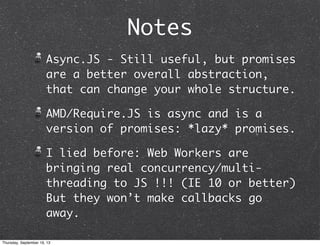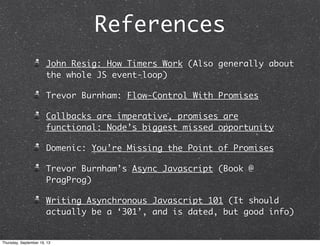Promises, Promises: Mastering Async I/O in Javascript with the Promise Pattern
- 1. Promises, Promises Mastering Async in Javascript with the Promise Pattern by Christian Lilley about.me/xml Thursday, September 19, 13
- 2. 1st, our Problem... Do Thing A. Do Thing B using output of Thing A. But Thing A hasn’t returned yet, & you don’t know when it will!!! Thursday, September 19, 13
- 3. Then, the *Name* YMMV. Ignore the name if you need to. also: ‘Futures’, ‘Deferrables’, et al. Some of those are misleading... But still pithier than my ‘Time- Independent Proxy Objects’ TIPOs! Better: ‘Timeless Values’, ‘IOUs’ Thursday, September 19, 13
- 4. The Nature of JS Thursday, September 19, 13
- 5. Thursday, September 19, 13
- 6. The Nature of JS (Terminology on this stuff varies: smarter people than me argue about ‘blocking’ vs. ‘non-blocking’, etc.) FWIW, JS doesn’t have ‘real’ concurrency or coroutines ‘Just’ a Single-Threaded Event Loop Which actually works really well, once you understand it. Hence, Node’s doing pretty well. Thursday, September 19, 13
- 7. The Default Option So, by default, Async in JS is all about callbacks. Callbacks get an otherwise blocking long-lived function out of the loop. They’re the exception to sequential, ‘blocking’ execution. Callbacks don’t return values, they have *side-effects* If you miss them, they’re gone forever Thursday, September 19, 13
- 8. Callback Reality So, callbacks work, but they’re a pain to compose and think about: tons of manual control-flow, custom event systems, caching of process states... People hate callbacks so much, they come up with colorful names for what they make their code look like: “Callback Hell”, or... “Callback Spaghetti”, or... Thursday, September 19, 13
- 9. step1(value1, function (output) { step2(output1, function(output2) { step3(output2, function(output3) { step4(output3, function(output4) { // Do something with value4, quick, before it disappears!!! }); }); }); }); Thursday, September 19, 13
- 10. PYRAMID OF DOOOM!!!! Thursday, September 19, 13
- 11. Doom is bad. Thursday, September 19, 13
- 12. Instead, how about... Thursday, September 19, 13
- 13. Q.fcall(step1) .then(step2) .then(step3) .then(step4); Nice! Although, what if we don’t want to chain everything at once?... Thursday, September 19, 13
- 14. var myPromise = Q.fcall(step1); // later... var newPromise = myPromise.then(step2); // much later... newPromise.then(step3).then(step4); // and some other time entirely... myPromise.then(step5) Thursday, September 19, 13
- 15. Or, Aggregation! Thursday, September 19, 13
- 16. // First, do one thing: var 1stPromise = Q.fcall(step1); // After that, do 3 other things var 2ndPromise = myPromise.then(step2); var 3rdPromise = myPromise.then(step3); var 4thPromise = myPromise.then(step4); // And only after those 3 finish... Q.all([2ndPromise, 3rdPromise, 4thPromise]).then(step5) Thursday, September 19, 13
- 17. So, what’s going on? Q.js is a utility library for generating promises. There are others, but Q is the gold-standard, and fully compliant with Promises/A+ spec. Subset of Q is in Angular: $Q JQuery has an implementation: avoid In the past, folks used Async.js, other utilities, for similar purposes. Thursday, September 19, 13
- 18. But, what’s a Promise?!? A promise is something very simple, but very powerful: a container that holds a value, or will hold a value a time-independent proxy for a remote/external object an instance of a class that has utility methods like .then() Thursday, September 19, 13
- 19. But, what’s a Promise?!? A ‘frozen event’ you can learn status of at any time. It’s a first-class object, so you can: Pass it Reference it Chain it All these things, in ONE PACKAGE Thursday, September 19, 13
- 21. Mailbox/Loading-Dock A package containing a new drive is coming. Will be delivered to this spot, but not sure when. var newDriveReady = orderDrive().then(openBox).then(copyData) var oldDriveGone = newDriveReady.then(wipeDrive).then(sellDrive) var newDriveInstalled = newDriveReady.then(installDrive) Q.all([newDriveInstalled, oldDriveGone]).done(downloadMoreMusic) Thursday, September 19, 13
- 22. Family Messaging Rather than standing waiting for your kid at school, & for spouse at work, make plans & do other stuff. var kidPromise = kidToSchool(); var childHome = kidPromise.then(smsReceived).then(pickUpKid); var foodAvailable = kidPromise.then(goShopping); var spouseHome = spouseToWork().then(vmReceived).then(pickUpSpouse); Q.all([childHome, spouseHome, foodAvailable]) .then(makeDinner).done(eatDinner); Thursday, September 19, 13
- 23. Money The callback approach to life is that you get paid for your work in perishable goods, like food. You have to preserve or sell it to be able to store it. Wouldn’t you rather just get paid in money, which you can spend, save, or even take out loans against? Thursday, September 19, 13
- 24. So, yes: it’s very nice syntactic sugar for composing more readable interactions, especially with callback-based applications. But that’s missing the bigger points: Persistent Events Cached Values from I/O operations Error-Handling Take async out of controllers, etc., w/ patterns like Angular’s Thursday, September 19, 13
- 25. Infinitely chainable: Promise methods return a promise, either transformed or original. Aggregation, with .all Furthermore... Thursday, September 19, 13
- 27. Consuming At first, consume promises from Angular's $HTTP, similar methods that return promises that you've maybe been ignoring all along. Inspect the state of a promise with: promise.inspect() (returns state & value or reason) promise.isPending() promise.isFulfilled() promise.isRejected() Thursday, September 19, 13
- 28. Consuming But once you've seen how much easier life gets when you take maximum advantage of Promises, you'll want to not only consume them, but produce your own... Thursday, September 19, 13
- 29. Producing - Step 1 Start Simple, by wrapping a basic value or function output in a Promise, so you can .then() or .all() Q.fcall(function() {return 10;}); Q.fcall(calculateSomething(data)); These promises will already be resolved. (They’re not async, right?) Thursday, September 19, 13
- 30. Producing - Step 2 Take callback-producing functions and turn them easily into promise-producing functions, especially in Node: var filePromise = Q.nfcall(FS.readFile, "foo.txt", "utf-8"); filePromise.done(handler); (‘nfcall()’ = node function call, but you can use it elsewhere) (There’s also nfapply(), of course.) Thursday, September 19, 13
- 31. Producing - Step 3 If you want to assemble your own promise-generating functions, from- scratch, and resolve or reject when/ how you wish, you want... Thursday, September 19, 13
- 33. What’s a Deferred? If a Promise is a container for a value, then a Deferred is the custodian of the container, taking care of it until it grows up & leaves home. The promise is a property of the deferred, which also has special methods for resolving the promise. So, re-using the previous example: Thursday, September 19, 13
- 34. var deferred = Q.defer(); FS.readFile("foo.txt", "utf-8", // callback to `readFile()` function (error, text) { if (error) { deferred.reject(new Error(error)); } else { deferred.resolve(text); } } ); // returns the promise before the async function completes return deferred.promise; Thursday, September 19, 13
- 35. The Promise is a separate object, to which the Deferred holds a reference: Thursday, September 19, 13
- 36. Deferred for creating, resolving promises Promise User/Consumer methods live here. .resolve() .reject() .promise .then() .done() .all() .inspect() .state .value .catch() .fcall() etc... Thursday, September 19, 13
- 37. Which can do What? You can’t change the state of a Promise directly. Only its Deferred object can do that. The Deferred is able to resolve or reject the Promise. If you don’t have the Deferred, you’re just a consumer. Promise is a bit like the compiled binary, Deferred is the source. Thursday, September 19, 13
- 38. Let’s beat that mailbox metaphor to death, shall we? Thursday, September 19, 13
- 39. If the Promise is the mailbox, then the Deferred: Is the Postman. Thursday, September 19, 13
- 40. No, not that one, thank God... Thursday, September 19, 13
- 41. If the Promise is the mailbox, then the Deferred: Is the Postman. The Postman is the only one who’s allowed to: Assign you a new mailbox. (ie. create a promise) Put new packages into the mailbox. (resolve the promise) Raise the little flag on the side. (set state of the promise) Thursday, September 19, 13
- 43. Promises Get You Clear, Declarative Control-Flow That Works Regardless of Time & Place Persistent Events, Clear Handlers Parallelism, Aggregation Caching of Async Values Excellent Error-Handling Thursday, September 19, 13
- 44. Advanced Patterns Thursday, September 19, 13
- 45. Promises from Other Libraries Not all promises are Promises/A+ spec I’m looking at you, JQuery. Also, some spec libraries are limited Wrap any other promise in conversion methods like Q(jqueryPromise); Just like wrapping a bare DOM element in JQuery, so you can use those methods. Thursday, September 19, 13
- 46. Angular & Promises Angular shows what you can do when you start thinking in Promises. Most async methods return promises. ($resource used to be an exception, but that’s changing in 1.2) Thursday, September 19, 13
- 47. Angular & Promises `resolve` property on routes: always resolved before controller instantiated, view rendered. allows controllers, views to be fully time-agnostic more modular, reusable, focused Make use of a *service* (a persistent singleton) to cache your promises, perhaps using... Thursday, September 19, 13
- 48. Lazy Promises Use a simple getter function that will return a promise if it already exists (whether resolved yet, or not), or generate one if needed. Works well with namespace() for creating hierarchies on the fly. Promises/A+ considering standardizing AMD loaders basically built on them Thursday, September 19, 13
- 49. function getDivision(divisionName) { if (!divisionObjects[divisionName]) { divisionObjects[divisionName] = $http.get(baseUrl + divisionName) .error(function(data, status) { console.error('getDivision failed, error:' + status) }); } else { return divisionObjects[divisionName]; } } Thursday, September 19, 13
- 50. Notes Async.JS - Still useful, but promises are a better overall abstraction, that can change your whole structure. AMD/Require.JS is async and is a version of promises: *lazy* promises. I lied before: Web Workers are bringing real concurrency/multi- threading to JS !!! (IE 10 or better) But they won’t make callbacks go away. Thursday, September 19, 13
- 51. Notes Node is recent enough that they certainly could have used Promises instead of callbacks. And servers are all about I/O. But everybody already understands callbacks... Robust, readable error-handling is another great feature of Promises. Thursday, September 19, 13
- 52. References John Resig: How Timers Work (Also generally about the whole JS event-loop) Trevor Burnham: Flow-Control With Promises Callbacks are imperative, promises are functional: Node’s biggest missed opportunity Domenic: You’re Missing the Point of Promises Trevor Burnham’s Async Javascript (Book @ PragProg) Writing Asynchronous Javascript 101 (It should actually be a ‘301’, and is dated, but good info) Thursday, September 19, 13
















![// First, do one thing:
var 1stPromise = Q.fcall(step1);
// After that, do 3 other things
var 2ndPromise = myPromise.then(step2);
var 3rdPromise = myPromise.then(step3);
var 4thPromise = myPromise.then(step4);
// And only after those 3 finish...
Q.all([2ndPromise, 3rdPromise,
4thPromise]).then(step5)
Thursday, September 19, 13](https://image.slidesharecdn.com/promisesasync190913-130919084936-phpapp02/85/Promises-Promises-Mastering-Async-I-O-in-Javascript-with-the-Promise-Pattern-16-320.jpg)
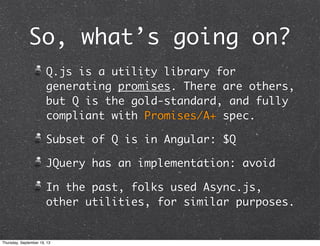



![Mailbox/Loading-Dock
A package containing a new drive is
coming. Will be delivered to this
spot, but not sure when.
var newDriveReady =
orderDrive().then(openBox).then(copyData)
var oldDriveGone =
newDriveReady.then(wipeDrive).then(sellDrive)
var newDriveInstalled =
newDriveReady.then(installDrive)
Q.all([newDriveInstalled,
oldDriveGone]).done(downloadMoreMusic)
Thursday, September 19, 13](https://image.slidesharecdn.com/promisesasync190913-130919084936-phpapp02/85/Promises-Promises-Mastering-Async-I-O-in-Javascript-with-the-Promise-Pattern-21-320.jpg)
![Family Messaging
Rather than standing waiting for your
kid at school, & for spouse at work,
make plans & do other stuff.
var kidPromise = kidToSchool();
var childHome =
kidPromise.then(smsReceived).then(pickUpKid);
var foodAvailable = kidPromise.then(goShopping);
var spouseHome =
spouseToWork().then(vmReceived).then(pickUpSpouse);
Q.all([childHome, spouseHome, foodAvailable])
.then(makeDinner).done(eatDinner);
Thursday, September 19, 13](https://image.slidesharecdn.com/promisesasync190913-130919084936-phpapp02/85/Promises-Promises-Mastering-Async-I-O-in-Javascript-with-the-Promise-Pattern-22-320.jpg)






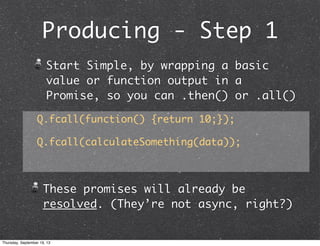
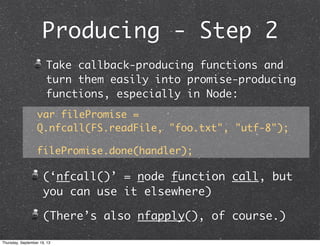


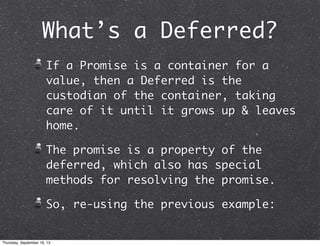












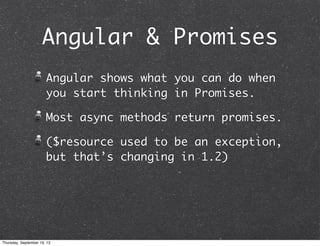
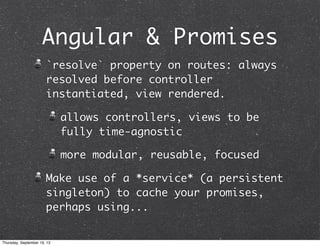

![function getDivision(divisionName) {
if (!divisionObjects[divisionName])
{
divisionObjects[divisionName] =
$http.get(baseUrl + divisionName)
.error(function(data, status) {
console.error('getDivision
failed, error:' + status)
});
} else {
return
divisionObjects[divisionName];
}
}
Thursday, September 19, 13](https://image.slidesharecdn.com/promisesasync190913-130919084936-phpapp02/85/Promises-Promises-Mastering-Async-I-O-in-Javascript-with-the-Promise-Pattern-49-320.jpg)
